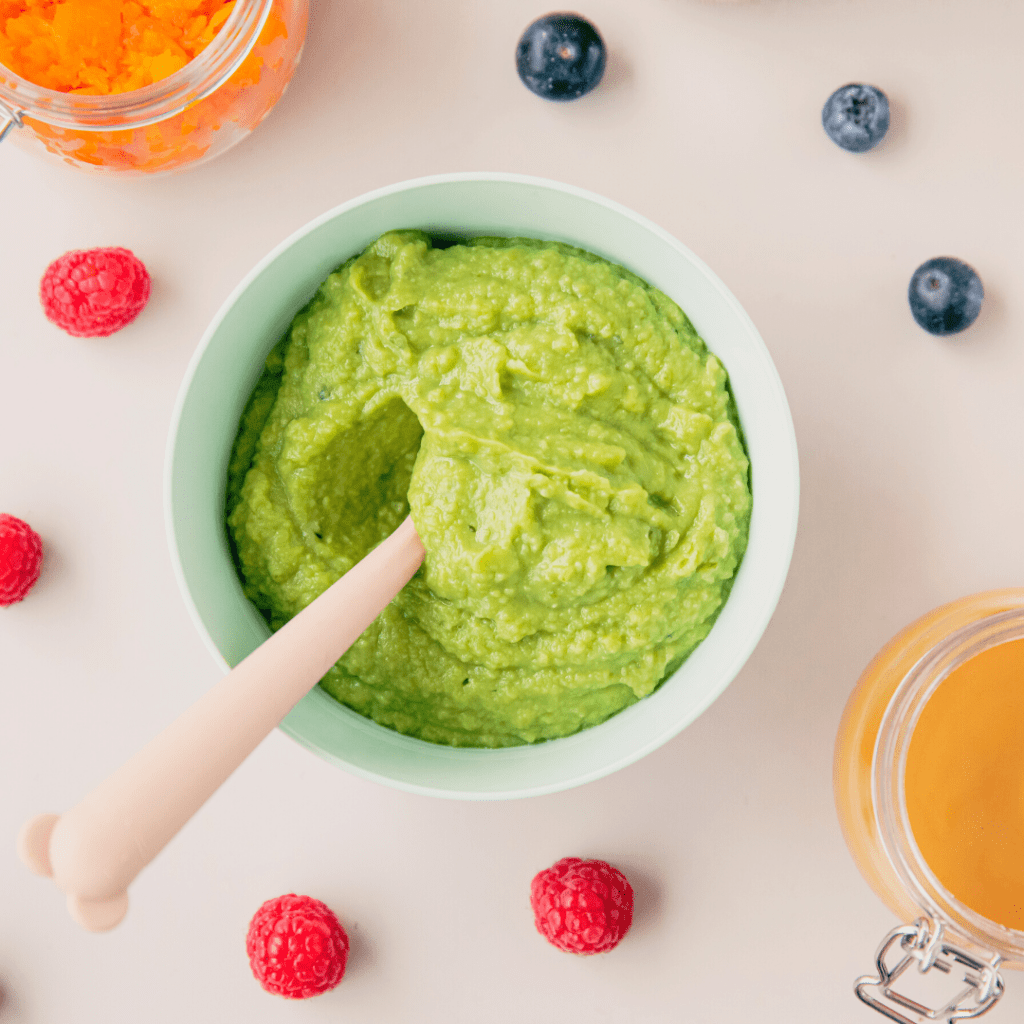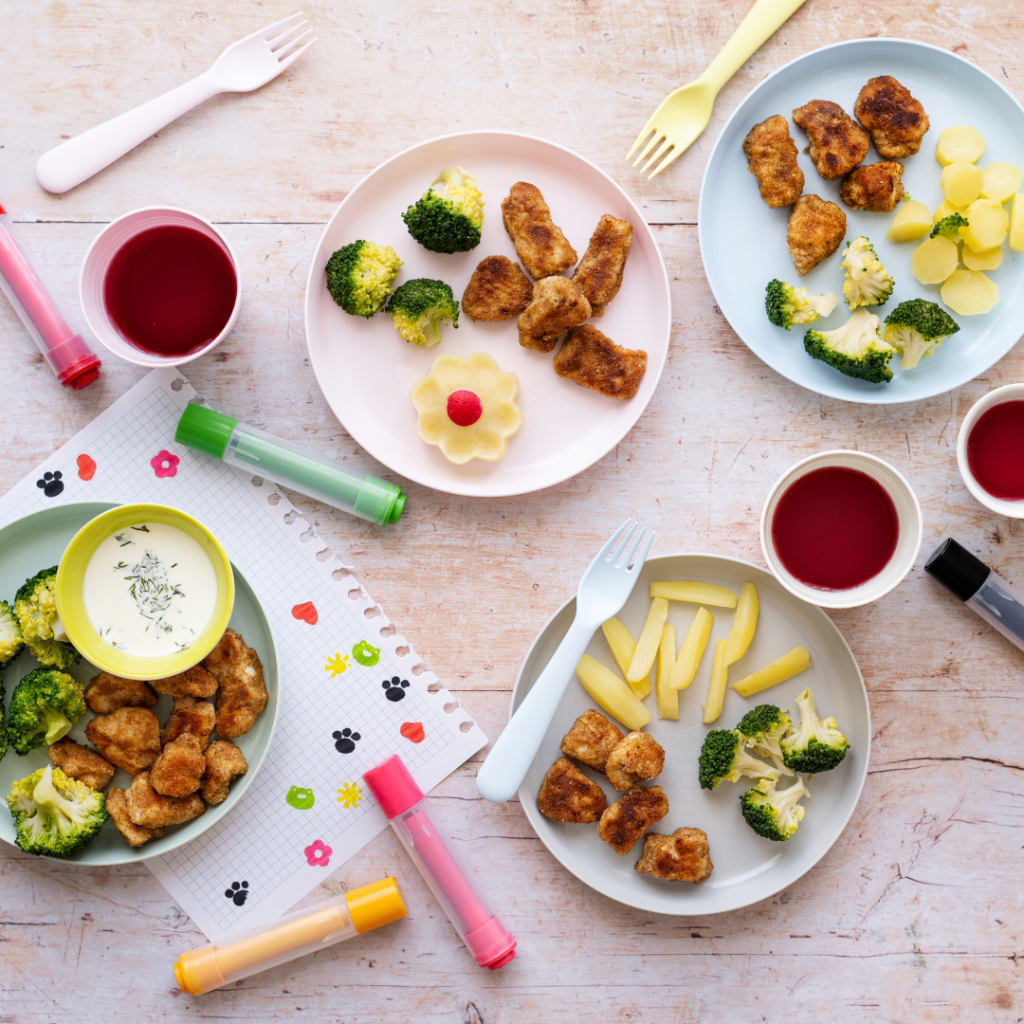**This post contains affiliate links, please view our disclosure policy for more details.
Dips can be so helpful to get picky toddlers and even babies to try new foods!
With an endless variety of dips to choose from, they make an excellent tool for encouraging picky eaters to explore new and even familiar foods in a fun way. Not only can dips help picky toddlers, but they’re also useful for keeping babies’ food moist and providing extra calories for your growing babies and toddlers!
If you’re struggling with a picky toddler at home (or are looking to avoid that experience as much as possible!), then you’ll need a well-rounded, holistic approach to managing/preventing picky eating. Our Feeding Toddlers course provides just that – it helps you set up a solid foundation for feeding and then gives you the best tips and strategies, taken right from our professional feeding therapy, to tackle picky eating (or stop it in its tracks!).
While we think dips are great, the common concerns we hear from many parents seem to be…
“What if my toddler will only eat a vegetable with a dip?”
“What if my child only licks the dip off (is it distracting from the main meal)?”
And finally…everyone wants to know…
“What dips are actually healthy for babies and toddlers?!”
So let’s dive into learning how dips can be so helpful and which ones to choose!
What age can I start offering dips?

You can start offering dips to your baby at around 6 months of age, once they’re showing the developmental signs that they’re ready to start solids. Of course, your baby won’t understand the concept of dipping food themselves, but they can eat the dip on its own (with their fingers or off a spoon) or you can dip a finger food for them and let them take over from there.
Dips for babies can be helpful for keeping dryer foods moist and therefore safer for new eaters who are just learning how to chew and swallow different textures. The added moisture allows babies to more easily maneuver food around in their mouth, and can be particularly helpful with keeping meat safe! If you’re serving your baby chicken or a meatball, adding a bit of marinara sauce would make the texture of the meat more moist and easier for baby to eat with a reduced risk of choking.
Dips also act as a great vehicle for babies to eat foods like rice or quinoa (which are hard to eat on their own). After mixing these foods into a dip, babies will be able to eat them using a spoon or their fingers. Rice mixed with guacamole is a perfect example of this!
The last reason why dips are so great to offer as early as 6 months of age is that they provide an easy source of calories to babies who may otherwise not be able to get much food in until they really learn how to eat more efficiently. High iron dips (like bean dips or liver purées) are excellent nutrition boosters that babies can benefit from, from day one.
How dips can help with picky eating

Dips and food play can go a long way when you’re trying to encourage a very picky kid or toddler to try new foods without saying “please take a bite”. Meat in particular tends to be high on the list of foods that toddlers tend to dislike, which can be concerning for a parent when you know your little one has protein and iron needs that must be met. So let’s look at some ways that dips can be used to help with picky eating and getting kids to try new foods.
Use dips for food play with your picky eater
Food play is a great way to encourage kids to try (and like) new foods because it will have your toddler touching, and likely eating foods that they wouldn’t otherwise go near…because it’s fun! When pressure around mealtime is removed, and you put them in a playful and stress-free eating environment, they can let go of inhibitions and be more willing to eat.
We can help guide our kids to play with their food by encouraging them to get creative and get down to the basic sensory levels like taste, smell, sound, and texture of food. All of these steps help them work towards the main goal which is, eventually, to eat it.
Now, it’s no secret that kids love dipping food into things – ketchup, water, anything they can get their hands on. Use this to your advantage if it’ll help increase the likelihood they’ll at least try new foods.

Get silly right along with them at dinner time and ask them if they want to take their broccoli for a “swim” in the yogurt, or even just water!
You can even encourage them to paint a picture with a dip, with no pressure to eat anything – just simply having fun with the dip in a new way, while holding a food they don’t typically eat in their hand as their “paintbrush”!
Top tip: Your little one might dip foods together that are unconventional and that’s okay! It doesn’t matter if they want to dip broccoli in ketchup. Even though we might think that’s weird – if it gets your toddler to eat broccoli – just roll with it! Be mindful of how you react to your toddler’s unconventional dip combinations as we don’t want them to think anything is “gross” or “weird” – just let them explore!
Use dips as part of a taste-test
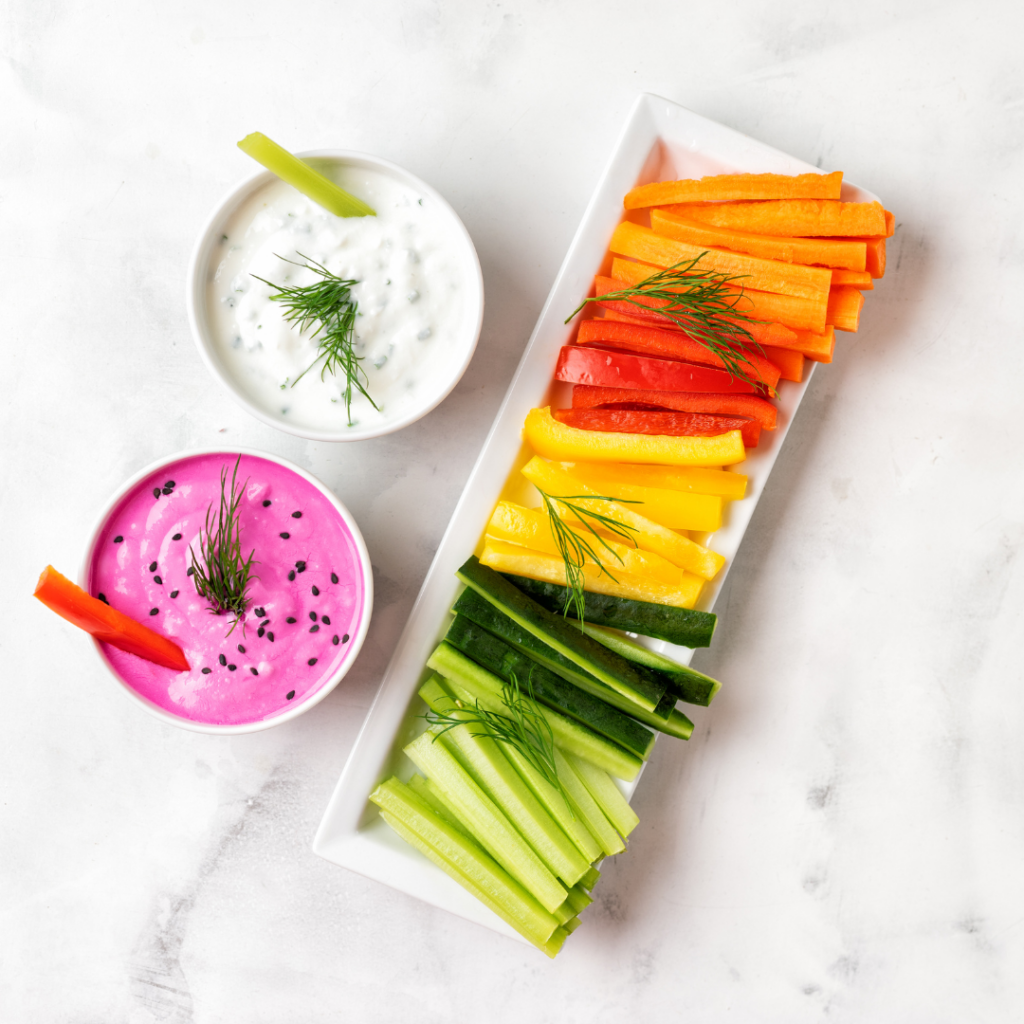
Provide your toddler with a few dip options when eating something new, or that they struggle with, such as meat. You can talk about how the meat tastes when you dip it in different sauces to tap into your toddler’s curiosity and get them to try it without actually asking them to eat it.
You can say something like “my chicken tastes sweet when I dip it in my plum sauce”. You can comment on how it’s sour when dipped in lemon juice or salty when dipped in an olive tapenade.
If that’s too far over your toddler’s head, try just commenting on the color (it’s red broccoli now when I dip it in ketchup!).
Your toddler will be intrigued, maybe start to wonder what it tastes like, and mimic your actions.
Keep in mind that this isn’t a one-time thing and it doesn’t only work with meat. Practice these playful tips over multiple months and use them when introducing fruits and vegetables, and really any kind of new foods that toddlers or picky eaters may refuse to try.
Use dips to bridge the gap from liked foods to new foods
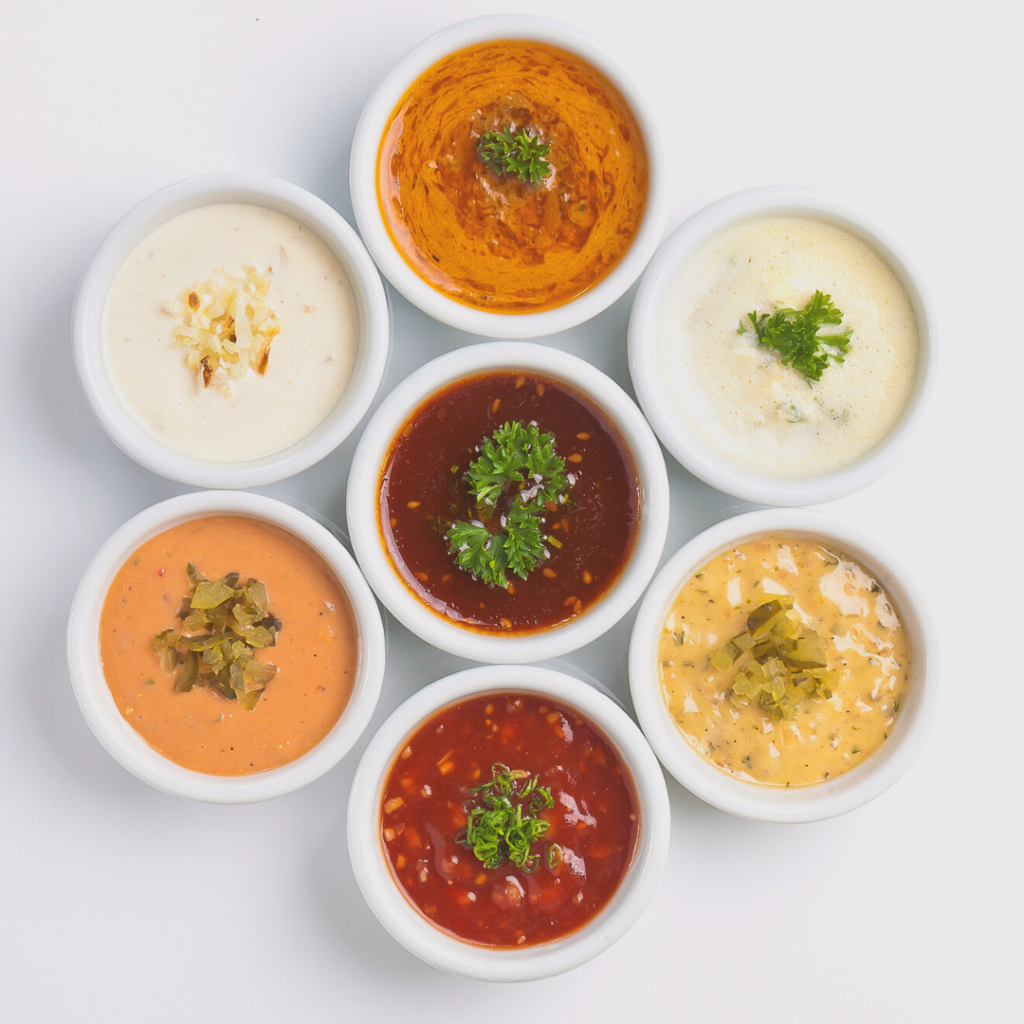
Dips can be a useful tool to bridge taste gaps by allowing picky eaters to taste something familiar alongside a non-favorite or new food too. Researchers conducted a study to see if pairing a familiar dip (that the child has already been exposed to and likes) with an unfamiliar new food, would increase their willingness to taste it (1). The results of the study confirmed that the children in the study were more willing to try a new food if it was offered with a familiar dip!
Therefore, we can take that peanut butter or ranch dressing flavor that your child already prefers and serve it with a new or previously refused food as a great strategy to broaden your toddler’s diet and bring familiarity to new foods!
What if my baby or toddler only eats the dip?

Dips can be a great tool for encouraging your baby or toddler to try new foods, but what do you do if they just lick the dip off of the spoon or the food and don’t actually eat the piece of food?
Well, there are a few different things you can try:
- Offer a small amount of dip with the meal and let them know that’s all the dip that’s available with that meal. Model to them how you add a little bit of dip to each piece of food before you eat it so that you don’t run out of dip before all of your food is gone.
- It’s easier to lick dip off a large piece of food versus a very small piece, so you can try cutting food into smaller bite-sized pieces. It may be less overwhelming if it’s a small piece of food rather than a large piece that would require them to take bites.
Ultimately, remember that dips are a food like any other food at the table. If it’s served, it’s fair game to generally allow your child to choose how much to eat of it without our interference. This follows the golden rule for preventing picky eating and building trust around food at the table.
If it’s hard for you to watch your child eat mostly (or only) dip, then be sure to focus on serving really nutrient-dense dips made from a healthy fat source (like the recipe at the end of this blog post!). Only offer it occasionally during meals or snacks to allow for opportunities to try other foods at other meals.
WHAT TO CONSIDER WHEN CHOOSING DIPS FOR BABIES, TODDLERS & PICKY EATERS

No salt or low salt added
Generally, we want to make sure we’re choosing dips that contain zero or low salt, especially for babies under 12 months of age. The recommended amount of salt for babies is about 200 mg/day from food sources, so considering many commercially prepared dips contain over 100 mg of sodium in a serving, it’s easy to see how this can add up. Going over the recommended amount of salt on occasion isn’t something to stress over, however, if it’s present in foods in excessive amounts, it builds up your baby or toddler’s affinity for salty foods and snacks.
Toddlers have a recommended salt intake of 800 mg/day, so while there is a bit more wiggle room, it’s still a good idea to look for low salt options. That’s why preparing dips for babies and toddlers at home is often the best way to ensure this (see our favorite dip recipe at the end of this post for inspiration!).
No or low sugar added
You also want to avoid added sugar in dips, which contribute to overall added sugar intake throughout the day. It’s recommended that added sugar be avoided for all kids under the age of 2, and after that, the recommendation is less than 10% of total calories.
Added sugar can show up in ingredient lists as brown sugar, cane juice, corn syrup, honey, and more. Pay attention to these unnecessary additions to dips that your little one may be consuming, especially if they consume them frequently.
Whole foods based with no additives

Ideally, you’re looking for dips that contain the fewest amount of additives, chemicals, or preservatives. Let’s take a quick look at the ingredients for Kraft Ranch dressing.
INGREDIENTS: SOYBEAN OIL, WATER, VINEGAR, SUGAR, EGG YOLKS, SALT, BUTTERMILK, CONTAINS LESS THAN 2% OF MODIFIED FOOD STARCH, GARLIC*, MONOSODIUM GLUTAMATE, XANTHAN GUM, WHEY, PHOSPHORIC ACID, ONION*, POTASSIUM SORBATE AND CALCIUM DISODIUM EDTA (TO PROTECT FRESHNESS), SPICE, PARSLEY*, DISODIUM GUANYLATE, DISODIUM INOSINATE, YEAST EXTRACT.
Try to avoid dips that contain ingredients like sugar, monosodium glutamate, and the many other additives found here. It’s even great to look for dips with oils or fats that come from anti-inflammatory sources, like olive oil or avocado oil vs. soybean or corn oil.
High-fat dips made from sources of healthy fats
Finally, opt for full-fat dips as well, as babies need a lot of calories as they grow! These can be especially helpful for underweight kids by providing extra calories in a meal, in turn helping them gain weight.
One of my favorite dips to recommend for babies or toddlers is full-fat Greek yogurt because you can flavor it any way you want. Whether that’s sweetened with mashed berries or used as a spiced dip with curry and garlic, it’s so versatile and really bumps up the nutrition by adding healthy fat to the meal.
We understand that accessibility, affordability, and staying sane are also important factors to consider when choosing what to feed your kids. Do your best and know that breaking “the rules” here and there, or in times where survival and sanity are priority, is also what amazing parents do, and what we fully support.
What are some healthy dips for kids?
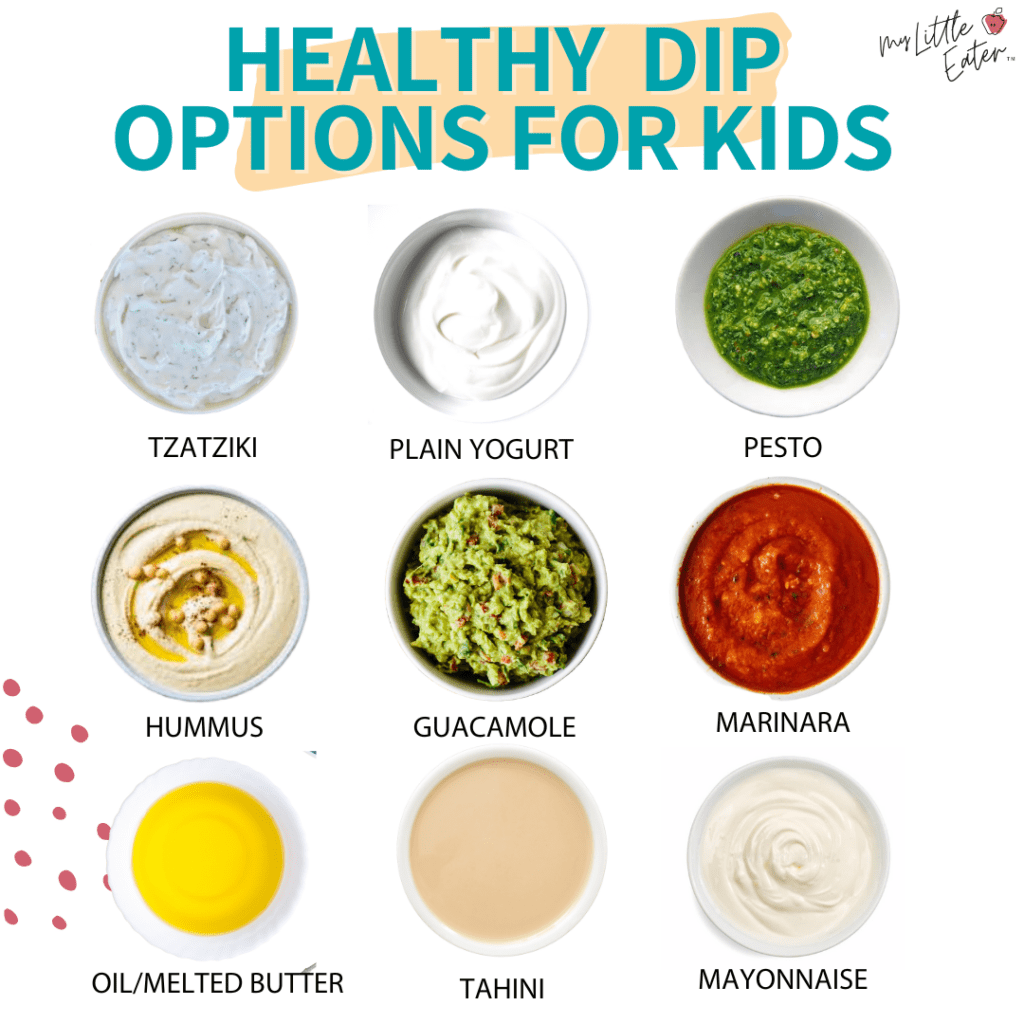
Dips can absolutely be a healthy addition to your baby or toddler’s diet. But be mindful of the dips you choose, as not all dips are equally nutritious, as mentioned above.
The right dips can actually be such an easy way to add extra calories to meals for your little, healthy eater and bump up the nutritional value!
Some dips that we love, include:
- Apple sauce or other fruit purees (unsweetened)
- You can boost the nutrient density by mixing in hemp seeds, chia seeds, or ground flax seeds for added protein, fat, and fiber.
- Full-fat, plain yogurt
- Regular or Greek yogurt work great. Greek yogurt is a bit thicker and is an easy replacement for sour cream in almost every recipe. It will provide more concentrated amounts of protein than regular plain yogurt, so if that’s something you’re focusing on for your toddler, it’s a great option.
- Pesto
- You can make dairy-free versions of this too!
- Melted butter or ghee
- Butter (especially grass-fed) is a great fat to boost calories in baby and toddler meals and can make veggies more palatable and meat easier to swallow. Ghee is a form of clarified butter, which is almost completely void of lactose and casein (milk protein). This makes it a great option for kids on lactose-free or dairy-free diets.
- Hummus
- A great plant-based dip that is super versatile when it comes to flavors and uses. We love mixing in roasted red peppers, basil, or extra garlic for flavor variation and suggest using it for dipping cooked veggies, meat, or bread.
- Black or white bean, lentil, or edamame dip
- Similar to hummus, using pulses like black or white beans, lentils, or edamame (a soybean) are great ways to vary the nutrients, textures, and flavors provided alongside almost any baby or toddler meal. Lentils provide a great source of plant-based iron, while white beans are known to be a higher calcium source and are a great option for dairy-free babies or toddlers who have trouble getting calcium otherwise.
- Guacamole
- Full of healthy fat, we like to keep it simple! Just mash some avocado on its own, or add some lime, garlic & onion powder and keep the other additions optional to make an easy avocado dip!
- Tzatziki dip
- Plain Greek yogurt mixed with garlic, dill, lemon, and cucumber. Check out my quick version of tzatziki inside the 60 day baby led feeding meal plan!
- Marinara sauce
- Easy peasy, nutritious, and versatile. Be careful as many store-bought marinaras can be high in sodium, so if you can’t make your own at home, you can also just do plain tomato sauce!
- Mayo
- Many think this isn’t healthy but it’s a great source of healthy fats, especially if you use an avocado-based mayo or another healthy base (Sir Kensington’s mayo line is great!).
- Balsamic vinegar
- Is there anything better than bread dipped in balsamic? Oh, I know… cheese and meat! Toddlers and sensory seekers who typically love the sour taste of lemon or limes will love dipping into this strong-tasting condiment.
- Olive oil
- So easy, goes on top of any food, and is a great way to boost calories. You can substitute it for any other heart-healthy oil as well, like avocado or flax seed oil!
- Tahini
- This is a sesame paste (used in the making of hummus), that adds a tangy, nutty flavor. Also full of healthy fats, we love to put this on toast, chickpeas, or tofu!
We also love using olive tapenades, ricotta dips, or making our favorite soft cheese spread/dip – labneh…so good!

We know that the not-as-nutritious dips, like ketchup and BBQ sauce which may have higher sugar and salt content, can stress some parents out. Especially when their toddler is dunking everything from a chicken nugget or grilled cheese to various veggies in it! Luckily, Primal Kitchen has a huge variety of delicious, healthy alternatives to traditional condiments, dips, and sauces! They even have unsweetened organic ketchup, perfect for the little ones who put ketchup on literally EVERYTHING. All ingredients used are whole foods based, and with no added sugar, you can’t go wrong. Use code MYLITTLEEATER to get 10% off your purchase!
If you look at the ingredient list for the Primal Kitchen ranch below (compared to the Kraft Ranch ingredients found in the previous section), you’ll see a better fat source (avocado oil), no preservatives, and no added sugars!
ingredients: Avocado Oil, Water, Organic Apple Cider Vinegar, Organic Egg Yolks, Sea Salt, Organic Distilled Vinegar, Organic Gum Acacia, Organic Guar Gum, Cream of Tartar, Organic Onion Powder, Organic Garlic Powder, Organic Lemon Juice Concentrate*, Nutritional Yeast, Organic Parsley, Organic Chives, Organic Dill, Organic Black Pepper, Organic Rosemary Extract.
But ultimately, my advice is not to stress too much about this. If dips like these entice them to try new foods, like veggies for example (which may otherwise be turned down), then focusing on this goal first is where you want to start. The benefits of eating new foods and enjoying mealtimes outweigh the downsides (especially if you’ve got extremely picky eaters or a tenacious toddler on your hands!).
If you want to offer these dips but are concerned about how much they’re eating, then try not to rely on their favorite dip for every single meal. Switch it up and rotate some of those healthier dips amongst the more processed options like ketchup, bbq sauce, and sweet and sour as well!
MY FAVORITE HIGH-CALORIE DIP TO GET KIDS TO TRY NEW FOODS
Here’s the perfect dip to use for fruits, waffles, crackers, toast, pancakes, and more! Basically, anything that pairs well with peanut butter is fair game! And you can easily modify the recipe to be nut free by substituting peanut butter for sunflower seed butter instead.
I recommend trying to offer this tasty dip alongside various fruits for your picky eater, and maybe even include some new ones they’ve never had before. Let them try a taste test of different fruits using a dip with a familiar flavor to them – you may be surprised with how helpful this is for picky eaters (and may even be able to add more fruits to their list of accepted safe foods).
For more simple recipes and quick and easy snack ideas, be sure to grab the Ultimate Snack Guide for toddlers! With more than 50 pages of easy snack ideas, including pre-packaged dietitian approved healthy options, throw-together pantry snacks, and simple recipes (including more dip ideas!), you’ll never have to think about what to offer for snacks again!
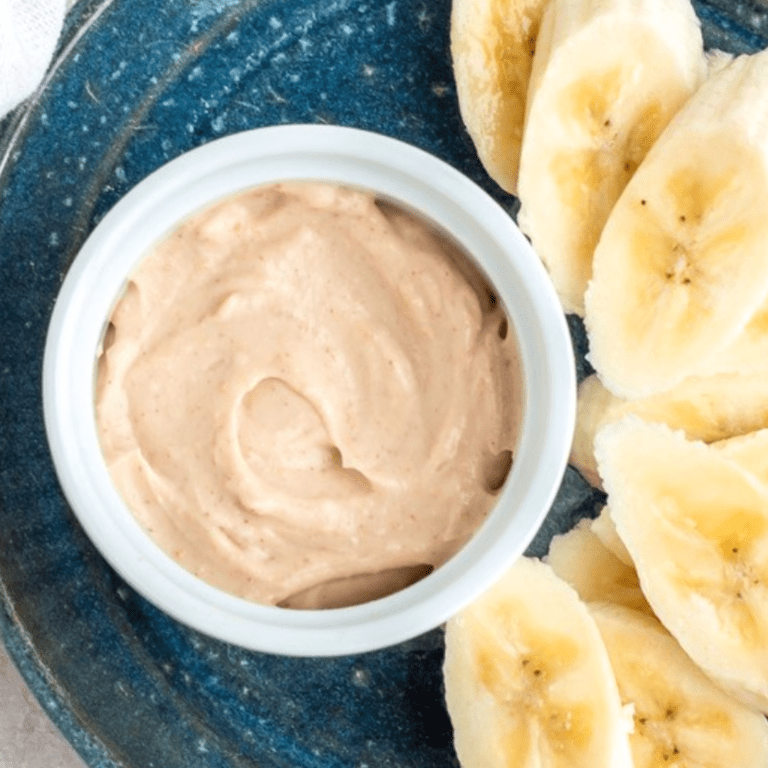
Bananas with Creamy Peanut Butter Dip
Equipment
- 1 small bowl
Ingredients
- 3 tbsps unsweetened coconut yogurt
- 1 tbsp all-natural peanut butter
- 1 banana (ripe, cut into thick slices)
Instructions
- In a small bowl, mix the yogurt and peanut butter together.
- Serve with the banana slices for dipping, and enjoy!
Notes
If you want to try more yummy dip recipes, grab the BEST healthy snack guide you’ll ever find for toddlers, and be ready to tackle snack times with ease!
Pin it to save the recipe and tips for later!
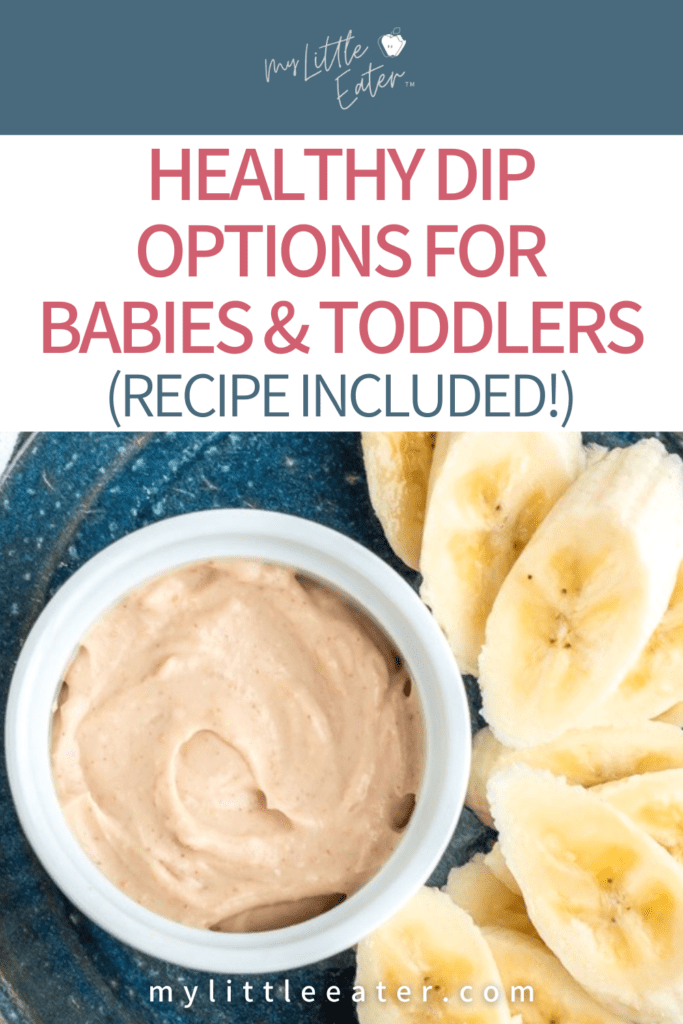
References:
- Pliner, P., & Stallberg-White, C. “Pass the ketchup, please”: familiar flavors increase children’s willingness to taste novel foods. Appetite, 34(1), 95-103, 2000.

about the author
CHELSEY LANDRY, RD
Community Dietitian at My Little Eater Inc., and bunny-mom to Hickory. Chelsey offers one-on-one counselling to parents of babies and toddlers that need more customized support. Learn more by booking a free discovery call with her today!
